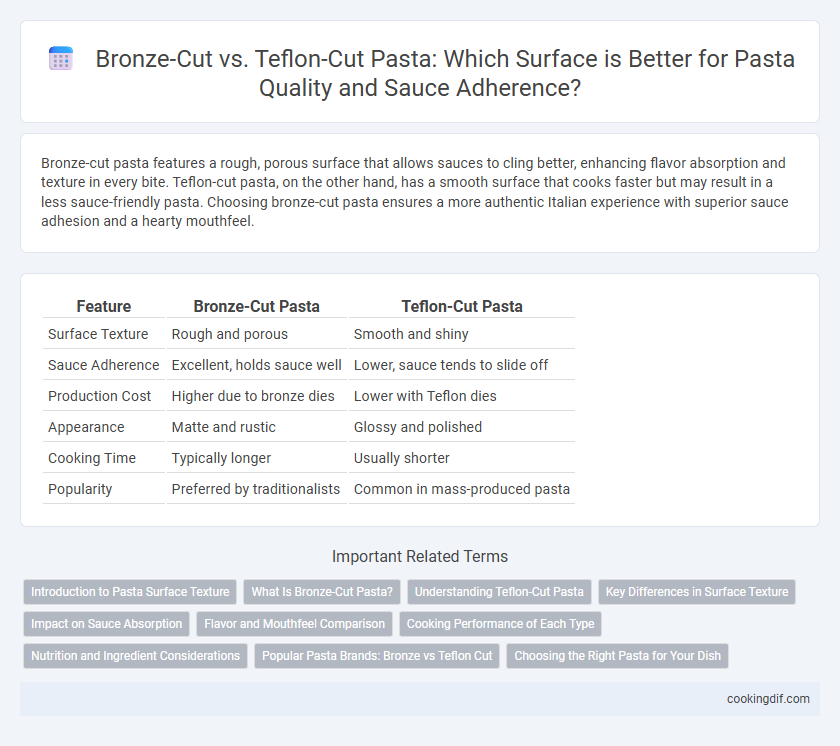Bronze-cut pasta features a rough, porous surface that allows sauces to cling better, enhancing flavor absorption and texture in every bite. Teflon-cut pasta, on the other hand, has a smooth surface that cooks faster but may result in a less sauce-friendly pasta. Choosing bronze-cut pasta ensures a more authentic Italian experience with superior sauce adhesion and a hearty mouthfeel.
Table of Comparison
| Feature | Bronze-Cut Pasta | Teflon-Cut Pasta |
|---|---|---|
| Surface Texture | Rough and porous | Smooth and shiny |
| Sauce Adherence | Excellent, holds sauce well | Lower, sauce tends to slide off |
| Production Cost | Higher due to bronze dies | Lower with Teflon dies |
| Appearance | Matte and rustic | Glossy and polished |
| Cooking Time | Typically longer | Usually shorter |
| Popularity | Preferred by traditionalists | Common in mass-produced pasta |
Introduction to Pasta Surface Texture
Bronze-cut pasta features a rough, porous surface that allows sauces to cling better, enhancing flavor absorption and creating a more authentic texture. Teflon-cut pasta has a smooth, polished surface resulting in a slicker texture that may hold less sauce but cooks more quickly. The choice between bronze-cut and teflon-cut directly impacts the pasta's mouthfeel and how well it integrates with different types of sauces.
What Is Bronze-Cut Pasta?
Bronze-cut pasta is made by extruding dough through bronze dies, creating a rough, porous surface that allows sauce to adhere better, enhancing flavor and texture. This traditional method contrasts with Teflon-cut pasta, which has a smoother surface due to non-stick dies, resulting in less sauce retention. The textured bronze-cut pasta is preferred by chefs for its ability to hold rich sauces and provide a more authentic mouthfeel.
Understanding Teflon-Cut Pasta
Teflon-cut pasta features a smooth surface created by extrusion through Teflon-coated dies, resulting in a sleek texture that reduces sauce adhesion compared to traditional bronze-cut pasta. This type of cut is favored for recipes requiring delicate or light sauces, as its less porous surface prevents overwhelming the pasta's flavor. Understanding the distinction between Teflon-cut and bronze-cut pasta aids in selecting the ideal pasta texture and sauce compatibility for culinary precision.
Key Differences in Surface Texture
Bronze-cut pasta features a rough, porous surface that allows sauces to cling better, enhancing flavor absorption. Teflon-cut pasta has a smoother, shinier texture resulting from the non-stick metal die, which produces a less textured finish. This key difference in surface texture affects sauce adhesion and overall mouthfeel, influencing the pasta dining experience.
Impact on Sauce Absorption
Bronze-cut pasta features a rougher, porous surface that enhances sauce absorption by allowing sauces to cling more effectively, creating a richer flavor experience. Teflon-cut pasta has a smoother texture, resulting in less sauce adherence and a lighter coating that may reduce overall taste intensity. Choosing bronze-cut pasta elevates traditional Italian dishes by maximizing sauce retention and mouthfeel.
Flavor and Mouthfeel Comparison
Bronze-cut pasta features a rougher, porous surface that retains sauce better, enhancing flavor absorption and creating a chewier, more textured mouthfeel preferred in traditional Italian cuisine. Teflon-cut pasta has a smoother finish, resulting in a slicker surface that allows sauces to slide off easily, producing a softer bite and milder taste experience. Flavor intensity and texture distinction make bronze-cut pasta favored for complex dishes, while Teflon-cut suits delicate, light sauces.
Cooking Performance of Each Type
Bronze-cut pasta features a rougher, porous surface that holds sauces better, enhancing flavor absorption and creating a more textured bite during cooking. Teflon-cut pasta has a smoother surface, resulting in a silkier texture but less sauce retention, which can lead to a less intense flavor experience. The cooking performance of bronze-cut pasta often yields a firmer al dente consistency, preferred in traditional Italian cuisine, while Teflon-cut pasta tends to cook faster and may become softer more quickly.
Nutrition and Ingredient Considerations
Bronze-cut pasta has a rougher surface that better absorbs sauces and retains nutrients from whole grain ingredients, enhancing flavor and nutritional value. Teflon-cut pasta offers a smoother texture, which may result in quicker cooking but can slightly reduce nutrient retention due to less sauce adhesion. Choosing bronze-cut pasta supports a more nutrient-rich and ingredient-forward experience, particularly with high-fiber or protein-enriched formulations.
Popular Pasta Brands: Bronze vs Teflon Cut
Popular pasta brands using bronze-cut methods produce noodles with a rougher, porous surface that better absorbs sauces, enhancing flavor retention. In contrast, Teflon-cut pasta features a smoother texture that offers a silky mouthfeel but may not hold sauce as effectively. Bronze-cut pasta, favored by artisan producers like De Cecco and Garofalo, is often preferred for traditional Italian dishes requiring robust sauce adherence.
Choosing the Right Pasta for Your Dish
Bronze-cut pasta features a rough, porous surface that allows sauces to cling more effectively, enhancing flavor integration, while Teflon-cut pasta has a smoother texture, resulting in a more slippery bite ideal for light, delicate sauces. Choosing bronze-cut pasta works best for hearty dishes like ragu or chunky vegetables, as the textured surface captures every bit of sauce. For dishes relying on subtle, creamy sauces or simple olive oil bases, Teflon-cut pasta provides a cleaner mouthfeel that lets the sauce's finesse shine through.
Bronze-cut vs Teflon-cut for pasta surface Infographic

 cookingdif.com
cookingdif.com